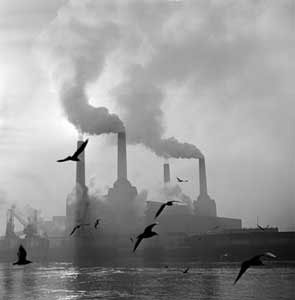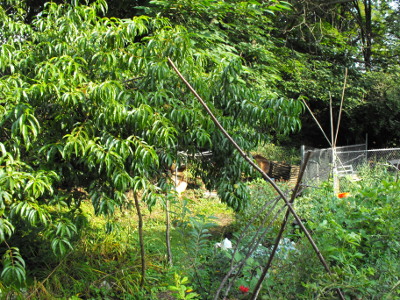
Heavy metals in garden soil
 Most
problems with garden soil can be remedied with judicious application
of organic matter or other supplements, but heavy metals are more
troubling. Although humans, plants, and soil microorganisms need
small amounts of many
heavy metals, high concentrations can be toxic.
To decide whether you should be concerned, look for these possible
sources of contamination near your garden:
Most
problems with garden soil can be remedied with judicious application
of organic matter or other supplements, but heavy metals are more
troubling. Although humans, plants, and soil microorganisms need
small amounts of many
heavy metals, high concentrations can be toxic.
To decide whether you should be concerned, look for these possible
sources of contamination near your garden:
- Lead paint on old buildings
- Chemical fertilizers or pesticides
- Gas stations and mechanics' shops
- Landfills
- Industrial factories
- Runoff from streets and parking lots
- Lead paint
- Treated lumber
The table below gives
information on the seven heavy metals found in soil that are regulated
by the EPA. Of these,
lead is the most likely to be found in your soil and is the one you
should be most concerned about.
| Heavy
metal |
Natural
levels (ppm) |
Unsafe
for vegetable gardening (ppm) |
Unsafe
for children to play (ppm) |
| Arsenic (As) |
3 - 12 |
more than 50 |
more than 200 |
| Cadmium (Cd) |
0.1 - 1.0 |
more than 10 |
more than 50 |
| Copper (Cu) |
1 - 50 |
more than 200 |
more than 500 |
| Lead (Pb) |
10 - 70 |
more than 500 |
more than 1,000 |
| Nickel (Ni) |
0.5 - 50 |
more than 200 |
more than 500 |
| Selenium (Se) |
0.1 - 3.9 |
more than 50 |
more than 200 |
| Zinc (Zn) |
9 - 125 |
more than 200 |
more than 500 |
You have to ingest heavy metals to get sick, which generally means eating plants that have sucked those heavy metals up out of the soil. Luckily, plants don't tend to accumulate lead the way they do some other heavy metals, so you can garden in soil with moderately elevated lead levels as long as you don't eat much dirt. At a lead concentration of 100 ppm, you'd need to eat two teaspoonsful of soil per week to create any problem; at 300 ppm, you'd need to eat 3/4 of a teaspoonful per week.

I wasn't particularly concerned about heavy metals in my garden, but the lab I sent our samples off to tested all of the problematic metals except for arsenic and selenium as a matter of course. Mom was more worried since her front yard is right beside a busy city street and her backyard (home of her vegetable garden) isn't all that far away from car exhaust and road runoff.
| Mule (1) | Mule (2) | CP3 (3) | Back (4) | Front (5) | Mom front | Mom back | |
| Zn | 8.3 | 7.8 | 12.5 | 7.5 | 8.5 | 12.5 | 28.9 |
| Pb | 1 | 1 | 1 | 1 | 1 | 3 | 7 |
| Cd | 0 | 0 | 0.1 | 0 | 0 | 0.1 | 0.3 |
| Ni | 0.1 | 0.1 | 0.1 | 0.1 | 0.1 | 0.1 | 0.1 |
| Cu | 1 | 1 | 0.9 | 1 | 1 | 1.1 | 1.2 |
| Est. total Pb | 37 | 38 | 40 | 37 | 37 | 64 | 108 |
| This post is part of our Holistic Soil Test Analysis lunchtime series.
Read all of the entries: |
Want more in-depth information? Browse through our books.
Or explore more posts by date or by subject.
About us: Anna Hess and Mark Hamilton spent over a decade living self-sufficiently in the mountains of Virginia before moving north to start over from scratch in the foothills of Ohio. They've experimented with permaculture, no-till gardening, trailersteading, home-based microbusinesses and much more, writing about their adventures in both blogs and books.
Want to be notified when new comments are posted on this page? Click on the RSS button after you add a comment to subscribe to the comment feed, or simply check the box beside "email replies to me" while writing your comment.

Hey, the one thing you did not test for is aluminum in the soil. This is still a new test most places don't think about doing. Here are some links about this in our soil: http://www.holmestead.ca/chemtrails/soiltest.html http://www.sodahead.com/united-states/toxic-levels-of-aluminum-found-in-soil-air-and-water-samples/blog-299669/ http://ruthlynnsworld.blogspot.com/2011/11/contrails-of-death.html
We actually did test for aluminum, but I didn't have a clue what I should do with that data, so I ignored it. Thanks for posting the links!
Thanks for posting the links!
Our extractable aluminum levels were 6 and 7 ppm everywhere except in the chicken pasture where it was elevated to 14. The soil test had a note "Soil range 10-250 ppm", which I assume means that's the normal amount of aluminum in non-troubled soil. Sounds like we're in good shape (although the slightly elevated levels in the chicken pasture are probably due to the feed we've brought in for the flock. We need to grow more of our own chicken feed!)
The toxicity of lead has been well known since ancient times. Greek and Roman authors like Dioscorides and Vetruvius wrote about it. Even today there is no blood-level of lead that is considered safe.
The international chemical safety card for tetraethyllead (the well-known anti-knock agent) is not a fun read. I'd definitely put it on my list of stuff to avoid! If you want to know how dangerous this stuff is, check out "of dead bodies and dirty streets"; in 1924, 32 of 49 workers in a Standard oil refinery working with TEL were hospitalized and 5 died. Also of interest is an article on the research into anti-knock agents presented to the SAE in 1994.
Have a read through the references of the lead poisoning article on Wikipedia. Dismissing all the evidence for the toxicity of lead as "pseudo-science" boggles the mind.
We owe a great debt of gratitude to Clair Patterson, a geologist who was trying to determine the age of the earth by looking at uranium/lead ratios in rocks and found all of his samples contaminated with lots of lead. You can read the transcript of the Caltech oral history interview with Pattersone here. Note that he wasn't initially interested in environmental effects. He was researching the age of the earth. The number that he came up with in the 1956 still stands today.